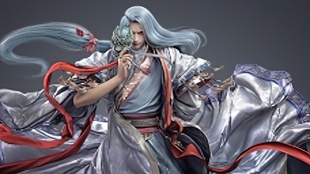您需要 登录 才可以下载或查看,没有账号?注册

x

Introduction
Hi, my name is Vivek and I am from India. I’m a self-taught artist trying to make compelling environments that tell stories. I started my 3D journey back in school as a hobby.
And now it’s something I want to do rest of my life. I just love Environment Art so much.
介绍
嗨,我的名字是Vivek,我来自印度。我是一个自学成才的艺术家,试图创造引人入胜的故事环境。我回到学校开始了我的3D之旅,作为一种爱好。
现在,这是我余生想做的事情。我只是非常喜欢环境艺术。
Goals
I have always had an interest in Japanese culture, food and architecture. And with this project, I wanted to challenge myself to make an environment using more effective and flexible ways. The deadline I set for myself was 45 days and thankfully, I was able to finish it in 50 days. I would like to thank all who have helped me with the project by giving me feedback.
I used concept art by amazing Huyang – https://www.artstation.com/aruariandance
目标
我一直对日本文化,美食和建筑感兴趣。通过这个项目,我想挑战自己,用更有效和更灵活的方式创造一个环境。我为自己设定的截止日期是45天,幸运的是,我能够在50天内完成它。我要感谢所有通过给我反馈来帮助我完成这个项目的人。
我使用了令人惊叹的湖阳的概念艺术 - https://www.artstation.com/aruariandance

Reference
Before starting to work on the scene, I studied the concept art and made a list of assets that I will need for the environment.
参考
在开始在场景中工作之前,我研究了概念艺术,并列出了我对环境所需的资产。
My checklist for reference was Color Pallete, Light and mood, Hero Asset Refs, Shrine Refs, Trim Sheet Ref, Props Ref and Foliage Refs.
Honestly collecting references is the most crucial part of any process. And it’s my favourite part too.
Let’s start with reference images for the shrine. I wanted to try using a “ Trim Sheet ” to model the entire shrine. I was so excited. My approach to making the shrine was modular, so I collected ref images for different parts.
i.e., roof, walls, floor, trim sheet, etc.
我的参考清单是调色板,光线和情绪,英雄资产参考,神社参考,修剪表参考,道具参考和植物参考。
诚实地收集参考资料是任何过程中最关键的部分。这也是我最喜欢的部分。
让我们从神社的参考图像开始。我想尝试使用“修剪表”来模拟整个神社。我非常兴奋。我制作神社的方法是模块化的,所以我收集了不同部分的参考图像。
即屋顶,墙壁,地板,装饰板等。
Since I was already using concept art, I had a lighting, mood and color palette ready from the start. I used “https://color.adobe.com/ ” to extract colors from the image.
由于我已经在使用概念艺术,因此我从一开始就准备好了照明,情绪和调色板。我使用“https://color.adobe.com/”从图像中提取颜色。
But as I saw different images on the web. I thought, maybe, let’s try a bit different approach with lighting.
但是当我在网络上看到不同的图像时。我想,也许,让我们尝试一种不同的照明方法。
This was my 3rd time doing an environment with foliage. So I had some idea on how to approach foliage. I will talk about it later so keep scrolling.
And here are some more refs of props which I think you can understand what they are about just from seeing them. Right?!
这是我第三次用树叶做环境。所以我对如何接近树叶有一些想法。我稍后会谈论它,所以继续滚动。
这里有一些道具的更多参考,我认为你可以通过看到它们来理解它们是什么。右?!
Modelling
I think a bit complex asset to model was the roof. I learned a lot of new techniques while making it. It was so much fun :). I use “ Blender 3D “ for most of my modelling and sculpting needs.
造型
我认为一个有点复杂的资产建模是屋顶。在制作过程中,我学到了很多新技术。:)真是太有趣了。我使用“ Blender 3D”来满足我的大部分建模和雕刻需求。
I used sculpted wood for wooden beams cause they were close to the camera so they needed more attention. As you can see I only gave it some minor corner details. I wanted woody details from textures.
我使用雕刻的木头作为木梁,因为它们靠近相机,所以它们需要更多的关注。如您所见,我只给了它一些小角落细节。我想要纹理中的木质细节。
For the rest of the props, I sculpted most of the models, made low poly versions of them, UV unwrapped, and baked them in substance painter, which is your typical process of making game-ready assets. Here are some high poly and low poy images of them. And I will talk about the foliage in its own section so chill and scroll.
对于其余的道具,我雕刻了大部分模型,制作了它们的低多边形版本,UV展开包装,并在实质画家中烘烤它们,这是您制作游戏就绪资源的典型过程。以下是它们的一些高多边形和低poy图像。我将在它自己的部分谈论树叶,所以冷静和滚动。
I kept assets fairly high poly cause I wanted to use the new NANITE feature in UE5, which I didn’t, cause the performance was still solid, even in cinematic mode.
我保留了相当高的多边形资源,因为我想在UE5中使用新的NANITE功能,但我没有,因为即使在电影模式下,性能仍然稳定。
Textures and Materials
Before making any other textures, the first thing I started making was TrimSheet. I used a blender addon called GrabDoc, an amazing addon which is free and irreplaceable when it comes to making trim sheets. So here’s the quick rundown of TrimSheet.
纹理和材质
在制作任何其他纹理之前,我开始制作的第一件事是TrimSheet。我使用了一个名为GrabDoc的搅拌机插件,这是一个令人惊叹的插件,在制作装饰片时是免费的,不可替代的。所以这是TrimSheet的快速概述。
First I made some IDs and sent them to Adobe Substance Painter, assigned different materials such as Rope, Cloth, Wood, Tiles, etc. Made some adjustments and tweaks to materials. And just like that, we have a fancy trim sheet ready to use.
And here is my trim material setup in Unreal Engine.
首先,我制作了一些ID并将它们发送给Adobe Substance Painter,分配了不同的材料,例如绳索,布料,木材,瓷砖等。对材料进行了一些调整和调整。就这样,我们有一个花哨的装饰板准备使用。
这是我在虚幻引擎中的修剪材质设置。
A quick TIP – use the “ NamedReroute ” node which is a sweet feature and helps to keep your material graphs organized.
I wanted to do less in Adobe Substance Painter and more in unreal engine, and keep materials highly customizable and tweakable which is frankly much better. It saves a lot of time and is easy to control. I love Quixel Mixer cause we can mix and tweak Megascans directly inside and get the result that was hard to do before. I used it to make moss and ground texture. And I really enjoyed this process.
For the next part, I would like to focus on the most important materials which were Moss layer material and Masks.
一个快速提示 - 使用“ NamedReroute ”节点,这是一个甜蜜的功能,有助于保持你的材料图井井有条。
我想在Adobe Substance Painter中做得更少,在虚幻引擎中做更多的事情,并保持材质的高度可定制和可调整,坦率地说,这要好得多。它节省了大量时间,并且易于控制。我喜欢Quixel Mixer,因为我们可以直接在里面混合和调整Megascans,并获得以前很难做到的结果。我用它来制作苔藓和地面纹理。我真的很喜欢这个过程。
在下一部分中,我想重点介绍最重要的材料,即苔藓层材料和面具。
So here’s the summary, I made a basic moss material function and plugged it in with base material in “ MatLayerBlend_Standard “ Node.
所以这里总结了一下,我做了一个基本的苔藓材质函数,并在“MatLayerBlend_Standard”节点中用基材插入它。
IMPORTANT – Always clamp alpha values to keep them between the range of 0 to 1.
Now let’s talk about Masks. Recently I learned about something really amazing, using a second UV channel. We can use it to make masks, paint and other extra useful things. Surprisingly always had an idea but never tested it before. I used second UV channels for masks which were cavity, fall off and edge respectively. Here is an example mask for the roof-
重要提示 – 始终钳制 Alpha 值以使其保持在 0 到 1 的范围之间。
现在我们来谈谈口罩。最近,我学到了一些非常了不起的东西,使用第二个紫外线通道。我们可以用它来制作面具,油漆和其他额外有用的东西。令人惊讶的是,总是有一个想法,但以前从未测试过。我使用第二个UV通道来遮罩,分别是空腔,脱落和边缘。这是屋顶的一个例子面具-
And for some extra details, I used MacroVariation texture that comes as a starter content.
对于一些额外的细节,我使用了作为入门内容的 MacroVariation 纹理。
Foliage
Before I have been making foliage in Blender and it was such a hard job. For this project, I decided to use Speedtree again. And I’m glad I did.
I collected many bamboo references to get an idea of how they grow, are structured, and are arranged around each other. And for the style, I used Ghost of Tsushima foliage as a reference. It’s an amazing game, be sure to play it. I couldn’t play it, cause I don’t have a Playstation. Here are the references.
树叶
在我用Blender制作树叶之前,这是一项艰巨的工作。对于这个项目,我决定再次使用Speedtree。我很高兴我做到了。
我收集了许多竹子参考资料,以了解它们如何生长,如何结构化,以及如何相互排列。对于风格,我用了《对马岛树叶的幽灵》作为参考。这是一个了不起的游戏,一定要玩它。我不能玩它,因为我没有Playstation。以下是参考资料。
I studied how branches and leaves are arranged on the stem. And experimented a lot on how to make them fluffy and dense.
A TIP to help you with foliage, use DistanceField and DFAO. It gives amazing results. And be sure to turn on AffectDistanceFieldLighting on foliage props. You can learn more about it here:https://docs.unrealengine.com/4.27/en-US/BuildingWorlds/LightingAndShadows/MeshDistanceFields/
我研究了树枝和叶子是如何排列在茎上的。并尝试了很多如何使它们蓬松和致密的实验。
帮助您处理树叶的提示,请使用距离字段和DFAO。它给出了惊人的结果。并确保在树叶道具上打开ImpactDistanceFieldLighting。您可以在此处了解更多信息:https://docs.unrealengine.com/4.27/en-US/BuildingWorlds/LightingAndShadows/MeshDistanceFields/
After modelling them in Speedtree, I imported them in unreal. I am using material that comes default with the Speedtree plugin. But for the wind, I’m using the “ SimpleGrassWind “ node.
在Speedtree中对它们进行建模后,我将它们导入到虚幻中。我正在使用Speedtree插件默认提供的材料。但是对于风,我使用的是“SimpleGrassWind”节点。
I used Quixel Megascans for the foliage texture. I could have modelled, sculpted, baked and painted them, to get those textures but I was on a deadline. So I gotta be fast. Right?!
An important thing to remember while making foliage is their “ VertexNormal Orientation “. You can read more about them here -” “.
I manually edited VertexNormals for smaller foliage cause I didn’t like the results Speetree was giving. And also used my custom material for them.
我使用Quixel Megascans作为树叶纹理。我本可以建模,雕刻,烘焙和绘画,以获得这些纹理,但我在截止日期前。所以我必须快点。右?!
制作树叶时要记住的一件重要事情是它们的“ 顶点正态方向 ”。你可以在这里阅读更多关于它们的信息-http://wiki.polycount.com/wiki/Foliage“”。
我手动编辑了VertexNormals以获得较小的树叶,因为我不喜欢Spietree给出的结果。并且还为他们使用了我的定制材料。
Lighting and Rendering
I have been using UE5 ever since its first preview was available. And with the release of the stable version, I was so hyped. I would like to confess that my love for Lumen is inflating day by day. I am using dynamic lights in my scene. And Only light which is casting shadows is DirecionalLight and the rest are just Fill lights.
光照和渲染
自从UE5的第一个预览版推出以来,我就一直在使用它。随着稳定版的发布,我被大肆宣传。我想承认,我对Lumen的爱一天比一天膨胀。我在场景中使用动态灯光。只有投射阴影的光是DirecionalLight,其余的只是填充光。
Yes, I know there are so many Fill Lights but I’m still getting the targeted frame rates. So, all good. :). And not all of them are casting light.
And for background and sky, I am using an HDRi map.
The real protagonist of this story was ExponentialFog. After using it the scene got so much better. So, always try using fogs in your scene if you can.
And here are the settings for DirectionalLight, SkyLight, and ExponentialHeightFog.
是的,我知道有这么多的补光灯,但我仍然可以获得目标帧速率。所以,一切都好。:)。并非所有人都在发光。
对于背景和天空,我使用的是 HDRi 贴图。
这个故事的真正主角是 ExponentialFog。使用后,场景变得更好了。因此,如果可以,请始终尝试在场景中使用雾。
这里是 DirectionalLight、SkyLight 和 ExponentialHeightFog 的设置。
Feedbacks
The most crucial step during production was getting constant feedback. I am part of this amazing community called “ Dinutsy Empire “. Everyone there is so cool and amazing. I was able to get these results thanks to them.
Here are some feedback shots:
反馈
生产过程中最关键的一步是获得持续的反馈。我是这个名为“Dinutsy Empire”的神奇社区的一员。那里的每个人都非常酷和令人惊叹。多亏了他们,我才能得到这些结果。
以下是一些反馈截图:
I took screenshots of every feedback and saved them on Pureref.
Always remember to ask for feedback before moving forward. You definitely don’t wanna mess something up and do the work, all over again. Do you?!
我对每个反馈进行了截图,并将它们保存在 Pureref 上。
永远记得在继续之前征求反馈意见。你绝对不想把事情搞砸并重新开始工作。你?!
Outro
It was so much fun to make this project and learned a lot. This project got more likes on Artstation than my Instagram posts combined hahaha!
After finishing a project, you always want to look back and see what could you have done to improve on the process and save time. And make a list of new things you tried and learned. It helps you keep motivated and feel good about yourself.
I hope I was able to provide you with any knowledge.
Thank you! And be sure to check out my Artstation.
奥特罗
制作这个项目非常有趣,并且学到了很多东西。这个项目在 Artstation 上的点赞数比我在 Instagram 上的帖子加起来还要多哈哈哈!
完成一个项目后,您总是想回顾一下,看看您可以做些什么来改进流程并节省时间。并列出您尝试和学习的新事物。它可以帮助您保持动力并自我感觉良好。
我希望我能够为您提供任何知识。
谢谢!一定要看看我的 Artstation。
|







 评分
评分







